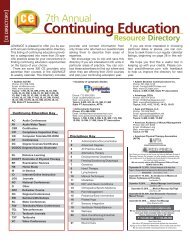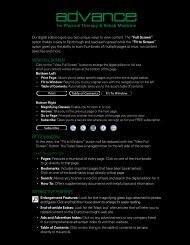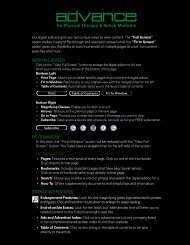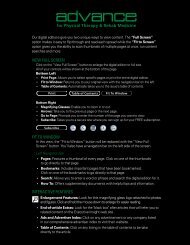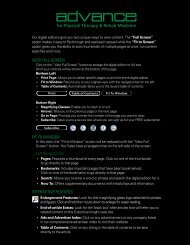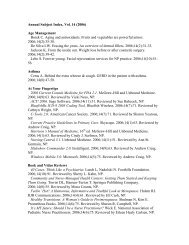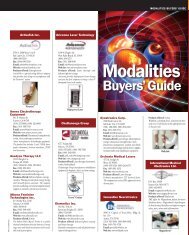Download - ADVANCE for Physical Therapy & Rehab Medicine
Download - ADVANCE for Physical Therapy & Rehab Medicine
Download - ADVANCE for Physical Therapy & Rehab Medicine
You also want an ePaper? Increase the reach of your titles
YUMPU automatically turns print PDFs into web optimized ePapers that Google loves.
over the years, I have consulted and<br />
treated hundreds of runners, from<br />
average joggers to marathoners,<br />
professional athletes and high<br />
school athletes. Foot and ankle<br />
injuries, including plantar fasciitis,<br />
Achilles tendonitis, fibularis<br />
tendonitis and posterior tibialis<br />
strain are the most common we see among this population.<br />
Treatment <strong>for</strong> these types of injuries presents<br />
additional challenges when dealing with runners given<br />
the nature of their injuries, typically chronic/overuse<br />
type injuries, and the typical runner’s propensity <strong>for</strong><br />
training “through the pain.”<br />
A speedy recovery <strong>for</strong> runners, like all athletes, is<br />
paramount. This fact underscores the need as a clinician<br />
to appropriately identify the nature of the problem from<br />
a biomechanical standpoint and everything contributing<br />
to it, and then implement a treatment approach<br />
addressing what’s been identified through our evaluation<br />
as comprehensively as possible.<br />
With treating foot and ankle injuries, it is easy to<br />
develop tunnel vision, focusing too narrowly on the<br />
affected tissues and not adequately considering the big<br />
picture. Beyond the specific injury, adjacent structures<br />
need to be assessed and treated <strong>for</strong> their potential role<br />
in the cardinal complaints. In addition, patient education<br />
about factors such as training routines, early injury<br />
recognition, footwear and overall conditioning needs<br />
to be a substantial part of any treatment plan. This will<br />
minimize recovery time and maximize ef<strong>for</strong>ts <strong>for</strong> prevention<br />
of future occurrences.<br />
So how do we satisfy optimal rehabilitation time<br />
and long-term success? We think the key is to use a<br />
comprehensive yet straight<strong>for</strong>ward plan that balances<br />
a combination of manual techniques, varied exercises<br />
<strong>for</strong> different purposes and extensive patient education<br />
about the injury, normal and abnormal physiological<br />
responses, and strategies to avoid injury in the future.<br />
Localized Treatment<br />
As with any injury, managing symptoms and promoting<br />
tissue healing is initially the primary focus. There<br />
is a wide variety of therapeutic exercises, manual techniques<br />
and modalities that can be employed to assist<br />
the body’s ability to heal. Balancing all of these options<br />
has proven a key factor <strong>for</strong> success in my experience.<br />
The most common modalities we utilize include various<br />
<strong>for</strong>ms of heat or ice, and educating patients about<br />
when to use either is important. It is also significant to<br />
avoid the habit of “icing after every treatment” or using<br />
heat be<strong>for</strong>e every treatment. Consider exactly what the<br />
desired treatment and tissue response is and apply the<br />
modality (or not) that best aids in that ef<strong>for</strong>t.<br />
[CoVER stoRY]<br />
Manual techniques: Manual techniques including<br />
joint mobilization and stretching, traditional soft-tissue<br />
manipulation and IASTM (instrument-assisted softtissue<br />
mobilization) can improve circulation, tissue<br />
remodeling and joint mobility, as well as modulate<br />
pain. Plantar fasciitis and tendonitis injuries tend to<br />
respond particularly well to the appropriately implemented<br />
manual techniques.<br />
Therapeutic exercise: I have also had excellent success<br />
treating these types of injuries with therapeutic<br />
exercises that focus on joint and soft-tissue conditioning.<br />
This involves prescribing exercises that promote<br />
ROM, healthy blood flow and oxygenation of tissues,<br />
along with joint lubrication, below a threshold that<br />
exacerbates the inflammatory response when dealing<br />
in the more acute phases of injury. Using very light<br />
resistance with high repetitions (i.e., three sets of 30 <strong>for</strong><br />
each exercise) helps promote healing but it is imperative<br />
<strong>ADVANCE</strong> <strong>for</strong> <strong>Physical</strong> <strong>Therapy</strong> & <strong>Rehab</strong> <strong>Medicine</strong><br />
13



